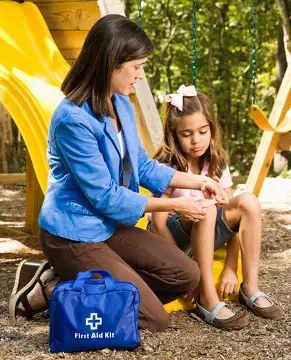Understanding Common Playground Risks

Creating an outdoor play space for children is an important part of starting an in-home daycare business, but it’s equally important for small business owners to understand common playground risks in order to prevent injury. Minimizing dangerous conditions can help home daycare provider to mitigate risks of litigation or liability, while providing a safer place for children to play outdoors.
The Benefits of Outdoor Play
It can be tempting for a new home daycare provider to simply choose not to provide an outdoor play space at all in order to eliminate common playground risks, but there are many benefits to outdoor play which should not be overlooked. Spending time outdoors encourages children to explore their environment and nurtures their natural curiosity. Active play outdoors can also help kids to develop motor skills and coordination.
In an era of predominately electronic entertainment, outdoor play can help to prevent a sedentary lifestyle. In turn, this can reduce the risks of childhood obesity and related health risks. For home daycare providers with a vested interest in helping the children under their care to develop healthy habits, a safe outdoor play space is an important aspect of their facility.
Common Playground Risks Childcare Providers Should Address
While there’s no reliable way of preventing each and every minor injury, it’s still of vital importance that home daycare providers work to create the safest possible environment for the children under their care. Being informed about common playground risks allows home daycare operators to address them before an injury occurs, thus preventing many future incidents.
-
Falls – The majority of childhood playground injuries can be attributed to simple falls. When children are still developing physically and learning the limits of balance, these falls can also be difficult to prevent. Home daycare providers can help to reduce the likelihood of an injury resulting from these falls, however, by ensuring safe surfacing of outdoor play areas. The ideal play space will be outfitted with cushioning, impact-absorbing material like wood chips, organic material or even shredded rubber.
-
Faulty Equipment – Playground equipment can be expensive to replace, but maintaining even older structures is imperative. Chains on all swings should be fitted with plastic sleeves which prevent pinching and injury to small hands, and those sleeves should be replaced at the first sign of peeling or breakage. Bolts should be covered to prevent scrapes and cuts, any splintered wood should be addressed immediately and structures too damaged to be repaired safely should be removed.
-
Lack of Supervision – While some accidents may be unavoidable, many could be prevented by simple supervision. Inattentive supervision allows children the opportunity to take unsafe risks and engage in dangerous play, which can easily lead to injuries. Children should always be closely supervised during outdoor play.
Keeping Kids Safe During Outdoor Play
Childcare providers should always be attentive during structured outdoor play times, ensuring children are behaving safely. Caregivers should never allow children to go down slides with a friend, as this can lead to both head and leg injuries. Jumping from swings or high structures should also be prevented. Drawstrings and cords should be removed from hooded shirts and jackets to eliminate strangulation risk associated with these cords becoming entangled with bars, ropes and chains on outdoor play structures. Home daycare providers should encourage parents to dress their children in clothing without drawstrings, or obtain permission to remove them if children are going to play outdoors. It’s never advised to damage a child’s clothing, so be sure to establish an open line of communication with parents regarding safe playground attire.
Another common playground risk encountered by children of many ages is not related to equipment, but to a lack of supervision and bullying. Physical bullying does still happen, and children may be reluctant to share this information with adults due to fear of retribution. Part of providing a safe place for children to play outdoors is ensuring a lack of bullying through supervision and careful observation.
Access to safe, well-maintained outdoor play areas can lead to healthier, happier children. With close supervision and attention to the condition of outdoor play spaces, home daycare providers can work to greatly reduce common playground risks. Access to safe, well-maintained outdoor play areas can lead to healthier, happier children.
